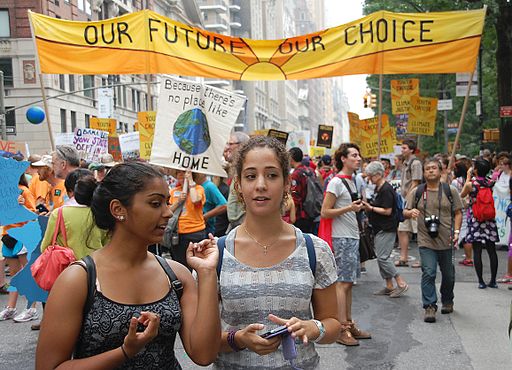 Back when I was training to become a scientist in the early 2000s, I also became an activist. First it was environmental issues, then labor and anti-war campaigns. It took some guts to step on a soapbox, and more to make a sign and maybe a noisemaker (like an aluminum can taped up with pebbles inside) to protest for a cause. But when you feel there’s something important that could be lost or people could be unjustly harmed, it’s exhilarating to band together and take a stand.
Back when I was training to become a scientist in the early 2000s, I also became an activist. First it was environmental issues, then labor and anti-war campaigns. It took some guts to step on a soapbox, and more to make a sign and maybe a noisemaker (like an aluminum can taped up with pebbles inside) to protest for a cause. But when you feel there’s something important that could be lost or people could be unjustly harmed, it’s exhilarating to band together and take a stand.
Thousands of people have marched in the streets in the United States and around the world during Donald Trump’s administration’s first 100 days, but not all protests are created the same. Unlike the Women’s March, the People’s Climate March and the Immigrants March, the March for Science isn’t built upon a social movement and a history and culture of activism. It’s unprecedented. While scientists and science advocates have focused on a few issues like nuclear weapons and air and water pollution before, now they feel that the very practice and enterprise of science itself is at stake.
Scientists have been involved frequently in government, sometimes even heading major agencies. But now they feel marginalized and disrespected, and evidence-based policy is far from a given anymore.
“They have tried to treat science as science, something beyond politics. But now that opportunity has passed,” says David Meyer, a sociologist at University of California, Irvine.
A protest can energize people, capturing the public imagination and media attention, but eventually that moment fades and everybody moves on. The work that goes into planning a giant march or rally pales in comparison to the long-term collaboration that keeps it relevant for years. In my experience, it involves lots of meetings, phone calls, and letter writing, usually to put pressure on local and federal policymakers.
My question is: Will the activists’ and supporters’ enthusiasm for the science march be sustained in the long term in spite of organizing challenges and a potentially fragmenting coalition? A wide range of groups and people have coalesced for the March for Science, and it wouldn’t be surprising if they didn’t all stick together afterward. But they must listen to each other and work together when possible if they want to transform this protest into a full-fledged social movement.

The March for Science had faces problems of diversity and inclusion from the very beginning. Although its leadership includes more than white-collar and white male scientists, like the Women’s March, they have been slow to recognize some glaring tensions. Statements about diversity—as well as efforts to bring in science advocates from groups with non-white concerns—have not accomplished much. But they have drawn attention to inequality and injustice in science, even if these disparities have been mirrored in the protest organization.
“There are divisions, but that’s common, especially when so many heterogeneous groups are involved,” says Kelly Moore, a sociologist at Loyola University in Chicago. In many social movements in history, Moore says, when white people or men are organizing, they’re often exclusionary and ignore others’ concerns.
She points out that climate change isn’t a high priority for people of color, for example. But many other issues and problems matter to science advocates beyond that. Under Trump, the Environmental Protection Agency now lacks an environmental justice leader; the Department of Justice disbanded its forensic science commission; and the Department of Education faces big budget cuts, including grants for low-income and first-generation college students. These are all particularly important for people of color, poor whites, people with disabilities, and others who often lack a voice in the halls of power and the ivory tower.
“I’d like to see the march reengage the American public in science,” says Emily Klein, an ecologist at the Southwest Fisheries Science Center and Farallon Institute, who was formerly involved in the march, tells me. She also would like scientists to make more of an effort to reach out to communities most affected by environmental challenges.
So what comes next? A few scientists and engineers will run for political office. Others, lacking an outlet in government, might partner with nonprofits. Many seek to continue their activism joining and working with a variety of organizations, like 500 Women Scientists, Union of Concerned Scientists (whose Science Network I used to be a part of), American Association for the Advancement of Science’s Force for Science, 314 Action, Society for Advancement of Chicanos and Native Americans in Science, and many others. I suspect many of these groups will persist and find new ways to make an impact, beyond the march. They will also help scientists engage in self-reflection, diversify their ranks, and participate in more public outreach.
But what if, in addition to wider recognition, science advocates formed an elite squad? I think we need a Ghostbusters for Science. Wherever people are politicizing science, they’ll be there to defend it. Wherever science is being ignored or manipulated, they’ll be there to restore it. Science does not concern itself with non-physical entities, ergo Ghostbusters for Science ain’t afraid of no ghosts!
Ramin Skibba is an astrophysicist turned science writer, based in San Diego.
Image: Climate Change protest via Wikimedia Commons
“First it was environmental issues, then labor and anti-war campaigns”
I disagree. Look at https://shawneemissionpost.com/2016/09/09/sm-easts-offense-proves-it-will-be-a-force-to-be-reckoned-with-in-48-6-rout-of-sm-northwest-54305